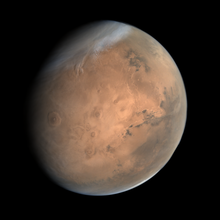
Diameter: 6779 Km
Length of a Day: 1 Day 37 Minutes
Length of Year: 687 Days
Average Temperature: -63(Approximate)
Number of moons: 2
The Red Planet, that is, Mars is the 4th planet in our Solar System and is the last rocky planet of the Solar System. All other planets after Mars are gas giants. It is the second smallest planet in the Solar System. Mars’s Atmosphere is very thin, the temperature is so low that it doesn’t support life on it. Many of the scientists suggest that there might be evidence of previous life on Mars, The rovers on mars have found evidence of the presence of liquid water on the surface in the past.
You probably wonder, that the biggest volcanoes exist on earth. But surprisingly, the biggest volcano of our solar system is on the Red Planet Mars called Olympus Mons. This volcano has a height of 25 Km, approximately 3 times the height of Mount Everest. This volcano is about 624 Km wide.
Just like the Earth, Mars also has Polar regions on its surface. Smallest distance between Earth and Mars is 54.6 million Kilometers. Mars comes this close to earth during its opposition. As of 2022, Mars’s opposition with Earth is on December 8th.
Many space agencies have done several missions for exploration on mars, and many of them have been successful, ISRO was the first space organization to send a satellite to mars’s orbit on its first attempt. If you are an amateur astronomer and want to see mars, the best time to see it would be during opposition. To stay updated about astronomical facts, events, planet opposition dates, etc. keep checking our blog.
-By Akshit Kumar Sutrakar
Reference: wikipedia, nasa.gov, weather.gov
Source(Image): Wikipedia
